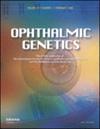BEST1 associated bestrophinopathies with angle closure and post-surgical malignant glaucoma.
IF 1.2
4区 医学
Q4 GENETICS & HEREDITY
引用次数: 0
Abstract
INTRODUCTION Mutations in BEST1 gene have been linked to the development of refractory angle closure glaucoma (ACG). This study aims to delineate the clinical characteristics, genetic mutations, and disease progression in patients with autosomal recessive bestrophinopathy (ARB) and autosomal dominant Best vitelliform macular dystrophy (BVMD) who are presented with treatment-resistant ACG. METHODS This retrospective analysis encompasses a comprehensive ophthalmic assessment, retinal imaging, and mutational profiling of six patients diagnosed with bestrophinopathy and concurrent ACG, with a particular emphasis on the risk of post-glaucoma filtration surgery malignant glaucoma (MG). Exome sequencing was conducted utilizing a next-generation sequencing (NGS) based gene panel. RESULTS The cohort included five patients with ARB and one with BVMD, with a mean (±SD) age at ACG diagnosis of 35.1 ± 6.9 years. NGS analysis revealed homozygous BEST1 variants in four patients (ARB; cases 1-4) and a heterozygous BEST1 variant in one patient (BVMD; case 5). One patient (ARB; case 6), despite a recessive pedigree, showed a single heterozygous variant, suggesting the presence of an undetected heterozygous variant indicative of compound heterozygous autosomal recessive inheritance. A novel non-frameshift deletion (c.841_843delTTC; p.Phe281del) was identified in case 2. Surgical intervention was required due to uncontrolled glaucoma in all cases except case 4. All five cases that underwent glaucoma filtration surgery developed MG, which was effectively managed with combined iridozonulo-hyaloido-vitrectomy (IZHV) and pars plana vitrectomy (PPV). Cases 5 and 6, harboring a heterozygous pathogenic variant (c.241 G>A; p.Val81Met), experienced refractory MG and corneal decompensation necessitating multiple interventions. CONCLUSION Genomic analysis plays a pivotal role in the management of bestrophinopathies with ACG. Characterization of mutational types facilitates prognostication and enables timely interventions. IZHV with PPV emerges as a promising standalone or adjunctive procedure for the management of glaucoma among patients with BEST1 mutations and ACG.与BEST1相关的嗜碱性蛋白病伴有角膜闭合和手术后恶性青光眼。
简介:BEST1 基因突变与难治性闭角型青光眼(ACG)的发病有关。本研究旨在阐明常染色体隐性遗传嗜酸性粒细胞增多症(ARB)和常染色体显性遗传贝斯特玻璃体黄斑营养不良症(BVMD)患者的临床特征、基因突变和疾病进展,这些患者均表现为难治性闭角型青光眼(ACG)。方法这项回顾性分析包括对六名确诊为嗜碱性粒细胞增多症并同时伴有ACG的患者进行全面的眼科评估、视网膜成像和基因突变分析,重点关注青光眼滤过手术后患恶性青光眼(MG)的风险。结果队列中包括五名 ARB 患者和一名 BVMD 患者,ACG 诊断时的平均年龄(±SD)为 35.1±6.9 岁。NGS 分析显示,四名患者(ARB;病例 1-4)存在同源 BEST1 变异,一名患者(BVMD;病例 5)存在异源 BEST1 变异。一名患者(ARB;病例 6)尽管具有隐性血统,但却显示出一个单杂合子变异,这表明存在一个未检测到的杂合子变异,表明存在复合杂合子常染色体隐性遗传。在病例 2 中发现了一个新的非帧移缺失(c.841_843delTTC;p.Phe281del)。除病例 4 外,所有病例均因青光眼无法控制而需要手术治疗。接受青光眼滤过手术的 5 例病例均出现了 MG,通过联合虹膜睫状体-视网膜切除术(IZHV)和玻璃体旁切除术(PPV)得到了有效控制。病例 5 和病例 6 携带杂合致病变体(c.241 G>A; p.Val81Met),经历了难治性 MG 和角膜失代偿,需要进行多次干预。突变类型的特征描述有助于预后判断和及时干预。IZHV和PPV是治疗BEST1突变和ACG患者青光眼的一种很有前景的独立或辅助方法。
本文章由计算机程序翻译,如有差异,请以英文原文为准。
求助全文
约1分钟内获得全文
求助全文
来源期刊

Ophthalmic Genetics
医学-眼科学
CiteScore
2.40
自引率
8.30%
发文量
126
审稿时长
>12 weeks
期刊介绍:
Ophthalmic Genetics accepts original papers, review articles and short communications on the clinical and molecular genetic aspects of ocular diseases.
 求助内容:
求助内容: 应助结果提醒方式:
应助结果提醒方式:


